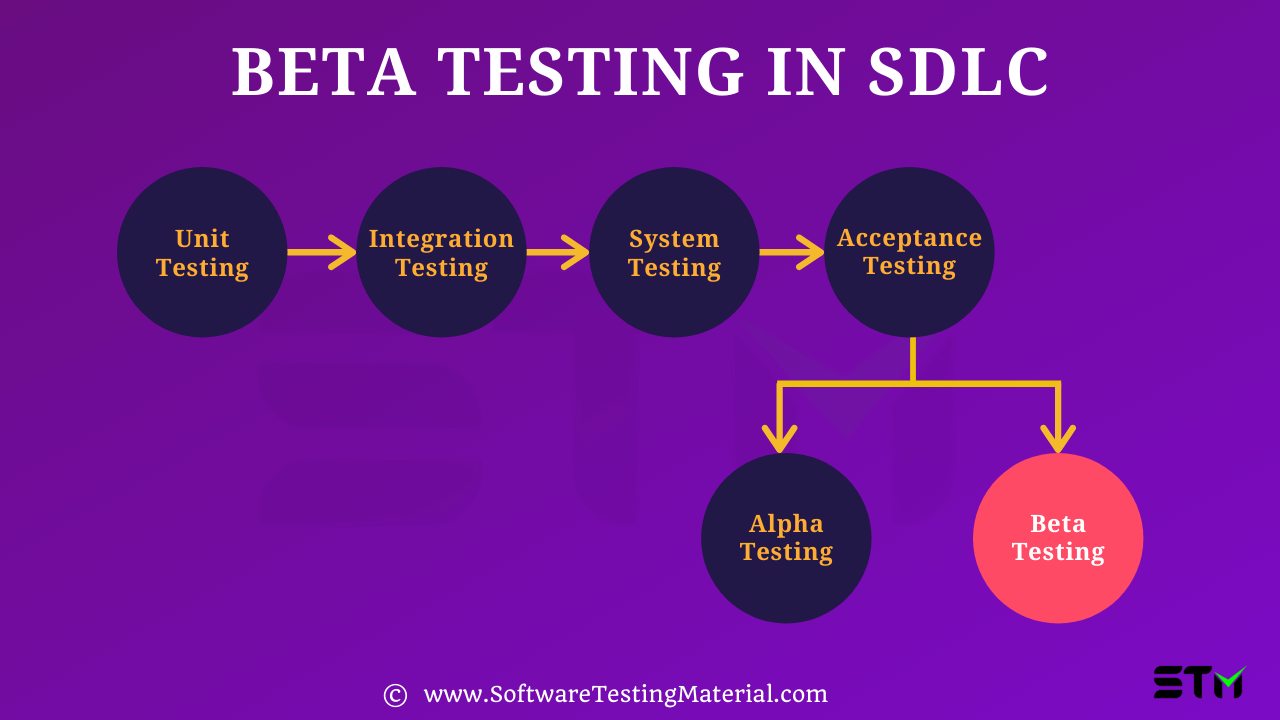Beta Testing – A Detailed Guide
What is Beta Testing?
In Software Testing, Beta Testing is a type of User Acceptance Testing. It is performed by a limited number of end-users (customers or real users) before delivery. Usually, it is done in the client’s place.

The objective of doing this testing is to validate application functionality, performance, compatibility, and usability in a real environment by real people, just to uncover real-world issues like business cases, speed issues, scalability, application performance before it goes to the wide audience for general use.
Beta testing gives an assurance that the application is well developed and satisfying business needs and expectations, its kind of a green signal before going to Live to be used by a wide end-user base.
One of the major advantages of this testing is we can get direct feedback from customers.
What is Alpha Testing?
A brief idea of Alpha testing.
Alpha testing is a user acceptance testing that is done by inhouse testers before the application goes live, objective is to perform a final round of testing and identify every type of issue which may have missed in previous rounds of testing. It is done by the testing team and issues are fixed immediately. The black box & white box testing approach is performed while performing Alpha testing.
Who are the Stakeholders
Stakeholders of Beta testing is
- Customers and usability expert
- SME (Subject Matter Experts)
- Project manager
- Quality/Test lead [Optional]
Entry and Exit Criteria:

What are the Entry Criteria for Beta Testing?
Let’s see the criteria to start beta testing
- When Alpha testing is completed, and a proper sign off is received from the testing team.
- The Beta version of the application should be available
- User manuals or help files, known issues list should be documented and must be kept ready to be published.
- A tool to capture real-time errors
So on the basis of Alpha testing signoff Beta Testing can be performed.
What are the Exit Criteria for Beta Testing?
Let’s see the criteria to pass beta testing
- No Showstopper or major bugs in the application.
- The feedback report should prepare for future versions of the product.
- Delivery of Beta Summary Report.
- Sign off on beta testing
Alpha Vs Beta Testing
| Alpha Testing | Beta Testing |
|---|---|
| First stage of user acceptance testing. | Second stage of user acceptance testing. |
| Objective is to make sure that application is working as expected, all functional and performance issues are closed, and application is ready for Beta testing. | To validate that application is satisfying customer needs and requirements completely, customer accept the system by validating all the business scenarios with approval that now system is ready to be launched to its real end users. |
| It is performed by In-house testing team. | It is performed by end users. |
| It is done in the premises where entire team is involved [test and development], it is called lab testing. | It is done at customer premises where no one from development and testing team is present, it is called real time testing. |
| Alpha Testing requires long execution cycle depends on what and how many issues are uncovered. | Beta Testing requires only few weeks of execution. |
| It is done after System testing, when testing team has completed functional, performance and compatibility testing, and system testing is completed, Alpha testing is performed. If any issue is found, on the basis of issue severity issue is fixed and again retesting and regression testing is done. Or Application goes with Open known Issues for Beta testing. | Beta testing is done after Alpha testing is done, With a testing sign off, when all major issues are closed and system is in ready state for use. |
| It requires test environment. | It doesn’t require test environment. |
| Both White box and Black box testing involves in this. | Mainly Black box testing involves in this. |
| Major issues are fixed immediately in Alpha testing. | Issues are collected from the end users and fix them later in Beta testing. |
| Testing, retesting and regression testing is done, means multiple rounds of testing is performed to find issues. | Beta testing is the final testing and it is done on final tested environment and it is done only once. |
| While Alpha testing main testable feature is in-depth functionality, compatibility, performance and usability. Here security and reliability is not a major testing concern. | While Beta testing main high level business scenarios, application reliability, disaster recovery, application security and usability is the main testing concern, all stakeholders should be satisfied with the application functionality and quality. |
| If any high severity issue comes while Alpha testing, cost to fixing is relatively less then Beta testing phase. | If any high severe issue comes in Beta testing then cost of fixing is very high, plus company creditability is also at risk. |
| System Testing is done before Alpha Testing. | Alpha Testing is done before Beta Testing. |
| Beta testing is done after Alpha testing. | Product is released to the public after Beta Testing. |
| Functionality, usability are tested in alpha testing. Reliability and Security testing are not performed in-depth during alpha testing. | Functionality, Usability, Reliability, Robustness, Security testing are performed during beta testing. |
| The build released for Alpha Testing is called Alpha Release. | The build released for Beta Testing is called Beta Release. |
| It evaluates the quality of the product. It answers “Does the product work?” | It evaluates the customer satisfaction. It answers “Do customers like the product?” |
| It ensures whether the application is ready of beta testing or not. | It ensures whether the application is ready for the production launch. |
| Goal is to find bugs. | Goal is to collect feedback from beta testers and evaluate them. |
| Stakeholders for this testing are In-house developers, Quality Assurance Team. | Stakeholders for this testing are Product Management, Quality Management, and User Experience teams. |
Beta vs Crowdsourced Testing
There are some differences between beta and crowdsourced testing even though both of these give product developers the benefits of getting feedback on their products before releasing them to the general public.
The main focus on crowdsourced testing is to find Bugs whereas the main focus in beta is user experience and product improvement.
Professional QA’s perform crowdsourced testing whereas real end-users (may or may not professional testers) perform beta.
In crowdsourced, testers follow specific scenarios and checklists whereas, in beta, testers just test the app in a natural way.
Crowdsourced testing lasts for a few hours to weeks whereas beta testing lasts a few weeks.
Crowdsourced testers get paid per bug whereas beta testes won’t always get paid.
Learn more on Crowdsourced Testing here
Types of Beta Testing
There are 5 types of Beta testing, which can be performed as per the project needs
1.Conventional Beta testing
2.Public Beta Testing
3.Technical Beta Testing
4.Focused Beta
5.Post-release Beta
Conventional Beta testing:
Pre-released product is distributed to the targeted market for use and feedback is gathered, on the basis of feedback collected from the users, improvement is done on the product, and then it is released to the entire world for general use.
Public Beta Testing:
Product features are launched to the public, feedback is collected from the end-users, and improvement is done
Technical Beta Testing:
The product is released to a specific set of employees within the organization so that the general type of feedback as well as technical feedback can be gathered and improvement is done.
Specific or Focused Beta testing:
The product is released to a specific set of people to get feedback on specific features of the software, for example, user authentication of the software.
Post-release Beta:
The product is released to the public with the name Beta Version. Users use it with the actual purpose of the application, feedbacks are captured and improvisation is done before future release.
Closed vs Open Beta Testing
1. Closed Beta Testing
In Closed beta testing, software or application tested by a specific set of people, this team validates and evaluate the software, check all the features, and operate it as a real end-user perspective with real scenarios. This is called a Beta version of the software or sometimes it is called Private beta as well.
2. Open beta Testing
Open beta testing refers to a pre-testing before a final version of the product, but it’s not restricted to the specific set of people, rather it is available in the market or to the public with ‘public beta version’, where any user can utilize the software, provide the feedbacks and report the issues. This testing leads to identify improvement areas, quality, and usability issues. All the inputs are captured and improvement can be done in the Final release of the software.
Advantages and Disadvantages:
Beta testing is the last testing of the testing life cycle, it is very important and can not be taken for granted. Because this is the only event where almost all stakeholders finalize the product and take go or no go decisions.
Advantages of having Beta testing:
- It concludes the Customer’s viewpoint for the software, whether the customers are satisfied or not.
- End users or SMEs are also involved in beta testing, so relevant feedback is received.
- It is final testing before the final version of the product, so it prevents the team from a big failure before going live.
- Real-time and real scenarios are tested, by real users so a lot of issues can be discovered which might have missed by the testing team due to a closed environment.
- Beta testing sessions are a very good platform to understand the business and customer requirements, and business in an operational way, which might be helpful to understand the client perspective, team can suggest more improvement areas, which in turn gives more work and tasks for future release and trust build-up from the client.
Disadvantages of beta testing:
- It is performed by end-users and business people, sometimes they are not aware of the operational flow on the new application, however, they know the requirements. This gap leads to spending extra time on the application, and more confusion while testing.
- Some time due to huge time on the beta testing cycle, production release gets delayed which makes a big impact on the overall business.
- A skill full business analyst plays a key role while doing beta tests. If the business analysts failed to understand the beta testing feedback then it leads to failures in future releases.
Why Beta Testing
Just like other testing types in Software Testing, it is also a very important activity, which saves the project team from the following failures,
- Errors and malfunctioning on Live environment
- Usability issues
- Performance and bottlenecks
- Unsuccessful operations
- Loss of data
If Beta testing is skipped then it can lead to a big failure, let’s assume the following scenarios
Assume the Alpha testing is finished for an application and the testing team has given the sign-off. The application is moved to production without beta testing. On Production, actual users have started using the software. When the users are submitting important data, and facing some calculation errors. In the realtime when they face calculation errors, it may impact the business. The real users will become panic and may leave the application permanently. They may lose trust in the application. They may face financial loss as well.
This entire situation will be considered as a big failure.
Sometimes organizations face legal issues if the organization had signed any agreement.
So to prevent these kinds of issues, we need to go for Beta testing. It helps the project team to take final approval on the software, get the feedback for the improvement and client’s approval for the Production.
How Beta testing is Performed
It should be done with proper planning, the following are the steps to follow.
1. Make your software ready
Just like it’s used by real users – the application should have all functionality incorporated, all in-depth functional flow should be tested prior and signed off with zero bugs.
2. Design Beta Testing Plan
It should include
The objective of beta testing
- Application should be easily accessible to all its users.
- Authorization and authentication should work correctly for all users
- All functional flows should work as expected
- The client should be able to execute business scenarios successfully
- The client should be satisfied with application functionality and usability.
Strategies to be used
- Is it a Private or a Public beta test
- Who would be targeted beta testers?
- Feedback or input gathering mechanism, how end-user will suggest improvements
- List of all end to end business scenarios
Roles and responsibilities
- Who is responsible for test execution
- Who is responsible for logging issues or enhancements.
- Who will maintain daily logs and beta test report
- Who will manage the communication channels like mailing all stakeholders, and updating the documents
Timelines and Schedule of the beta test
Timeline and schedule are defined and communicated in advance to the entire team and management, so proper action is taken in case any severe functional or usability flaw is observed.
Tools selection:
As per the product feature and requirement, the beta tool is selected.
3.Beta Tester agreements
When the company goes for public beta testing it hire beta testers and all beta testers have to sign an agreement related to software confidentiality for e.g. tester will not disclose any information or its details to anyone until the software goes live and not available for public use.
4. Once the Beta tester hired, brief them their roles and responsibilities
Every beta tester should understand the objective of the test and they should follow a strict timeline.
5.Collect Feedback
When the beta tester starts the testing, feedback should be gathered. Feedback can be in any form like it can be an issue, or an improvement, or suggestion, or usability concern. All kind of feedback should be discussed and should be implemented if they are found valid.
Challenges in Beta Testing
There are some challenges in this and the following are the top 5 challenges which are faced by the team.
- Hiring skill full beta tester is tough, a tester who knows domain, and business as well along with testing skills.
- Getting relevant feedback about the product is difficult because testers may log everything as an issue because they are new to the application.
- Involving end-users in test cycles is difficult sometimes. Involving End user is very important because they only can provide the right feedback about a particular operation, but since their availability or presence is not sure, it becomes difficult to take their feedback on time
- In the end, a big list of feedback is made, from this list prioritization of feedback is difficult.
- Sometimes Beta testing cannot be accomplished in a strict timeline, it’s more like a Business end to end testing which is done in an exploratory testing way. Due to this, Beta testing takes huge time, and getting feedback on scheduled time is a big challenge
Beta Testing Software
Beta testing tools help you to avoid failures before the application goes to the Public. There are a lot of tools available that will help the team to go Live without any surprising defects. Every tool has different features and functionality, the team needs to choose it as per their requirements.
The following are some example of tools
- Centercode.com
- Usersnap.com
- Usertesting.com
- TryMyUI.com
- Prefinery.com
- Validately.com
- Webengage.com
- Ubertesters.com
How to become a Beta tester
Some developers try to get user feedback on their apps or features from the real users before they release those officially to the general public.
You can become a beta tester for these apps and try them by joining beta programs or early access.
As a beta tester, you will get a privilege to see new products, features, and bug fixes before they become public.
Let’s see some of the beta testing products and examples.
How to become a Beta tester for Apple

You can become a beta tester for Apple. You can test-drive pre-release versions and help them make their next release of iOS, iPadOS, macOS, tvOS, and watchOS bug-free.
Check this link to become an Apple beta tester
Similarly, you can become a beta tester for Android Apps too.
How to become a Beta tester for Android Apps
On Google play store there are millions of apps available in every segment, some apps are updated on daily basis, for performance, for better quality, for better usability.
You have to enroll yourself voluntarily to provide feedback on the applications.
To become a beta tester follow these steps
- Go to Google Play Store and search for applications/games for which you want to become a beta tester.
- Check the application/game, if it allows its users to work as Beta tester for the application.
- Follow the onscreen instructions. Opt for the ‘Beta Tester’ program. Beta Program sign up will take some time.
- You can check your apps/games for which you are assigned as a Beta tester.
- Beta testers are not always paid, but if they are paid the earning starts from approximately $10 per test to $100.
For more details check this link.
In Conclusion:
Beta testing is extremely important in any development project, and it should be considered on top priority before any major release. End-users feedback will certainly improve the current release as well as give directions for future release. Beta testers are in huge demand in the Gaming industry and Mobile app Industry.
FAQ’s – Beta Testing
Who is eligible to participate?
1. Most of the companies expect you to be atleast 18 years old.
2. You must be able to write and speak english fluently.
How much money can you make as a beta tester?
You can earn $1-$20 for most tests (or more) on the side and help impact product development for exciting new products.
How are payments made?
Depends on company to company. Mostly payments are made via PayPal after the end of a project.
Related posts:
- How To Become A Freelance Software Tester
- What is Crowdsourced Testing – Detailed Guide
- 15 Best Crowdsourced Testing Companies In 2020







